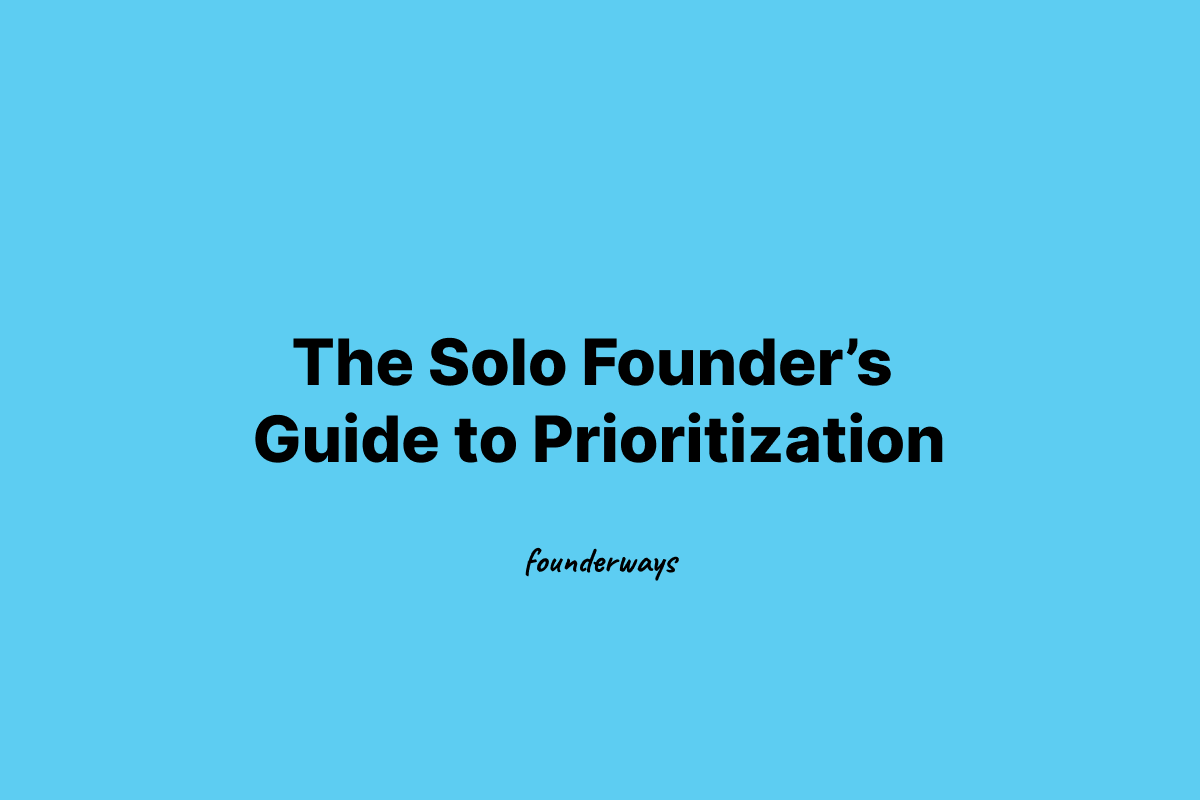The Solo Founder’s Guide to Prioritization: What to Work on First (and Why)

You’re the founder, the marketer, the product person, and the support desk.
One minute, you're tweaking your homepage. Next, you're halfway through a content strategy, mid-conversation with a potential customer, and questioning whether you should pivot your offer.
Sound familiar?
So how are you supposed to know what to work on first?
You need a filter.
Most solo founders fail not because they’re lazy or untalented. They fail because they spend months on the wrong things—at the wrong time.
This guide will help you fix that.
The Real Problem: Equal Weight Syndrome
Your to-do list doesn’t tell you what matters.
It just throws everything at you like confetti:
- Grow your audience
- Launch the product
- Set up systems
- Post every day
- Redesign your site
- Learn the latest growth tactic
As a solo founder, your time is limited. You need to treat it like gold—not sprinkle it across every shiny object.
Here’s how to decide what to do right now—and what to put on pause.
The Solo Founder Prioritization Filter (3-Part Framework)
Use these three filters together:
- Impact – Will this move the business forward?
- Personal Advantage – Am I naturally good at this?
- Stage Fit – Does this match where I am right now?
If a task passes all three, it’s a green light.
1. Impact: Is This the 20% That Moves the 80%?
Not all tasks are created equal. Some drive sales, subscribers, and momentum. Most just feel productive.
Ask yourself:
- What’s directly tied to revenue, reach, or retention?
- Would I do this if I only had 2 hours today?
- If this works, will it create momentum?
Examples of high-impact tasks:
- Talking to potential customers
- Testing or pre-selling an offer
- Publishing something valuable
- Following up on warm leads
Examples of low-impact traps:
- Polishing things that haven’t earned attention
- Tinkering with layouts, colors, or workflows
- Staying “in research mode” forever
💡 Quick tip: At the end of the week, write down your top 3 actions.
Ask: Did these actually move the business forward—or just fill time?
2. Personal Advantage: Am I Playing to My Strengths?
You’re not building in a vacuum. You’re building as you—with your own energy, skills, and preferences.
Ask yourself:
- What feels natural for me but difficult for others?
- What do I dread doing—no matter how "important" it looks?
- What could I keep doing even if I wasn’t seeing fast results?
Examples:
- If writing flows easily, don’t force yourself into video.
- If you love teaching, lean into workshops, coaching, or interactive formats.
- If systems energize you, build in that zone first.
When you align with your strengths, you gain two things: momentum and staying power.
3. Stage Fit: Am I Solving the Right Problem Right Now?
What matters most changes depending on your current stage.
| Stage | Focus | What That Looks Like |
|---|---|---|
| Exploring | Learn what people need | Talk to people, test problems, gather real feedback |
| Building | Create something useful | Offer something simple, test it early, get real results |
| Growing | Reach more of the right people | Build systems, share consistently, refine positioning |
| Scaling | Remove yourself from bottlenecks | Delegate, automate, and double down on what's already working |
Ask yourself:
- Am I jumping ahead before I’ve nailed the basics?
- Am I working on growth tactics without something proven to sell?
- What should I be focused on at this point?
Don’t let advanced strategies distract you from doing the next right thing.
When You Don’t Prioritize, You Pay for It
If you skip this filter, here’s what happens:
- You’re always busy—but not moving
- You’re drained by things you’re not good at
- You burn time solving problems that don’t matter yet
That’s not a productivity problem. That’s a prioritization problem.
A 5-Minute Prioritization Exercise
When you feel stuck, overwhelmed, or spinning your wheels, stop and ask:
- Impact: If this works, will it actually matter?
- Personal Advantage: Does this play to my natural strengths?
- Stage Fit: Does this make sense for where I am right now?
Write down your answers. Pick the one task that hits all three filters.
That’s what you work on next.
Stick it on a note. Put it where you’ll see it. Protect that focus like your business depends on it—because it does.
Final Thought: Prioritization Is Strategy
You don’t need to do everything.
You need to do the right things—at the right time—in the right way for you.
This is what separates spinning wheels from sustainable progress.
Use the 3 filters. Trust your stage. Lean on your strengths.
The rest can wait.
